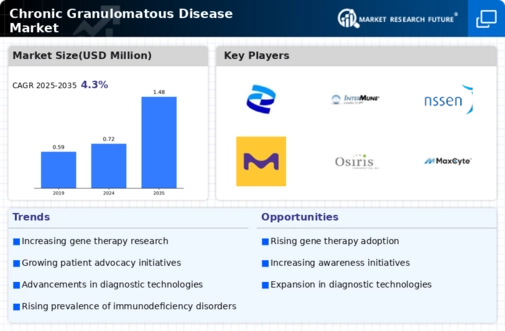Advancements in Gene Therapy
Recent advancements in gene therapy present a transformative opportunity for the Global Chronic Granulomatous Disease Market Industry. Innovative treatments targeting the genetic mutations responsible for CGD are emerging, potentially offering long-term solutions for affected individuals. These therapies could significantly improve patient outcomes and quality of life, thereby increasing the market's attractiveness to investors and healthcare providers. As gene therapy continues to evolve, it may lead to a more robust pipeline of products, contributing to the anticipated growth of the market, which is projected to reach 1.48 USD Billion by 2035.
Rising Awareness and Education Initiatives
Enhanced awareness and education initiatives regarding Chronic Granulomatous Disease are pivotal for the Global Chronic Granulomatous Disease Market Industry. Increased public and professional knowledge about CGD leads to earlier diagnosis and treatment, which is crucial for managing the disease effectively. Organizations dedicated to rare diseases are actively promoting educational campaigns, which could result in a higher number of diagnosed cases and, consequently, a greater demand for therapeutic options. This growing awareness is expected to contribute positively to market dynamics, fostering an environment conducive to growth and innovation.
Growing Investment in Rare Disease Research
The Global Chronic Granulomatous Disease Market Industry benefits from increased investment in research focused on rare diseases. Governments and private organizations are allocating more resources to understand and develop treatments for conditions like CGD. This trend is likely to enhance the development of novel therapies and diagnostic tools, thereby expanding the market. As funding increases, the potential for breakthroughs in treatment options rises, which could lead to a more competitive landscape. The anticipated compound annual growth rate (CAGR) of 6.71% from 2025 to 2035 reflects the optimism surrounding this investment trend.
Increasing Prevalence of Chronic Granulomatous Disease
The rising incidence of Chronic Granulomatous Disease (CGD) globally is a primary driver for the Global Chronic Granulomatous Disease Market Industry. As awareness and diagnostic capabilities improve, more cases are identified, contributing to a projected market value of 0.72 USD Billion in 2024. This increase in diagnosed cases necessitates enhanced treatment options and patient management strategies, thereby stimulating market growth. Furthermore, the prevalence of CGD is expected to rise, leading to a greater demand for therapies and interventions tailored to this condition, which could further elevate the market's value in the coming years.
Emerging Markets and Healthcare Infrastructure Development
The expansion of healthcare infrastructure in emerging markets is a significant driver for the Global Chronic Granulomatous Disease Market Industry. As countries develop their healthcare systems, access to diagnostics and treatments for rare diseases like CGD improves. This trend is particularly evident in regions where healthcare investments are increasing, leading to better patient outcomes and higher treatment rates. The growth of healthcare facilities and services in these markets is likely to create new opportunities for market players, thereby enhancing the overall market landscape.

















Leave a Comment